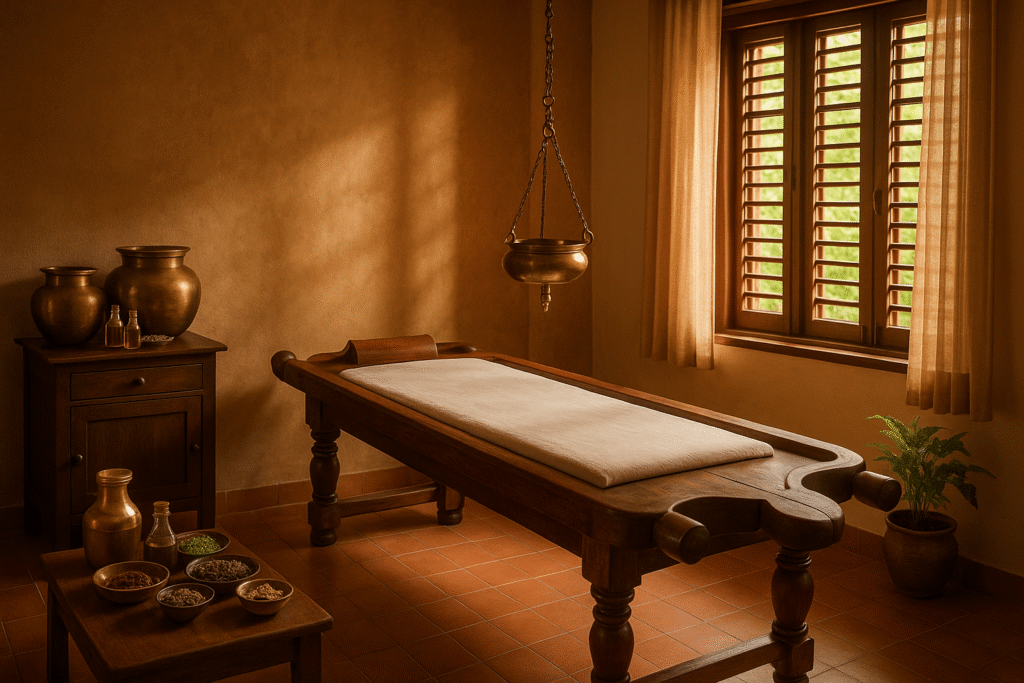Feeling tired, bloated, or emotionally drained?
Thousands are turning to an ancient Ayurvedic detox called Panchakarma — not just to cleanse their body, but to reset their entire life. Could this time-tested therapy be the reset your body needs?
What Is Panchakarma Therapy?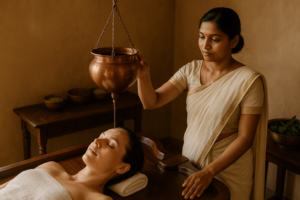
Panchakarma is a traditional Ayurvedic detox program designed to remove deep-rooted toxins, balance the doshas (Vata, Pitta, Kapha), and restore natural health. The term “Panchakarma” means “Five Actions” in Sanskrit — referring to five core detox therapies that purify both body and mind.
This traditional Indian detoxification process isn’t just physical. It supports emotional healing, mental clarity, and total rejuvenation. Whether you’re experiencing chronic stress, poor digestion, hormonal imbalance, or simply feel burnt out, this Ayurvedic body cleansing approach may be exactly what you need.
Why Do People Choose Panchakarma?
In today’s world, we’re surrounded by stress, processed food, poor sleep, and pollution. Over time, these cause ama (toxins) to build up in the body. This leads to:
- Digestive problems
- Brain fog
- Chronic fatigue
- Inflammation and mood swings
- Skin breakouts
Panchakarma detox programs work at the root, removing those built-up toxins and restoring your body’s natural ability to heal.
Top Benefits of Panchakarma Therapy
✅ Detoxifies your entire system
✅ Boosts digestion and metabolism
✅ Improves sleep and emotional balance
✅ Supports hormonal health
✅ Strengthens your immune system
✅ Clears skin and promotes radiance
✅ Sharpens mental focus
✅ Supports long-term Ayurvedic lifestyle reset
Backed by Science:Studies published on PubMed suggest Panchakarma helps reduce inflammation and oxidative stress — two major causes of chronic diseases.
The 5 Core Therapies of Panchakarma (The “Pancha” Actions)
| Therapy | Function | Dosha Targeted |
| Vamana (Therapeutic Emesis) | Induced vomiting to release toxins | Kapha |
| Virechana (Purgation) | Herbal laxatives to clean intestines and liver | Pitta |
| Basti (Enemas) | Medicated oil or decoction enemas for colon detox | Vata |
| Nasya (Nasal Cleansing) | Medicated oils/powders into nostrils to clear head | All |
| Raktamokshana (Bloodletting) | Blood detox (rare today) | Pitta |
The Panchakarma Process: What to Expect
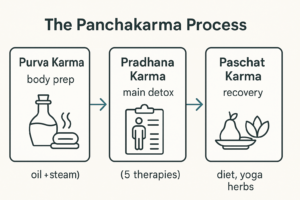
Panchakarma isn’t a one-time session — it’s a deeply personalized Ayurvedic detox program. The process is broken down into three main stages:
1. Purva Karma (Preparation Phase)
- Deepana & Pachana: Boosts digestion
- Snehana: Internal + external oleation (oiling)
- Swedana: Herbal steam therapy
Duration: 3–7 days
- Pradhana Karma (Main Panchakarma)
The primary cleansing phase using selected therapies based on your dosha and health needs. Supervised by a certified Ayurvedic doctor.
- Paschat Karma (Post-Therapy Care)
- Easy-to-digest meals (like khichdi)
- Herbal support and lifestyle changes
- Gentle yoga and meditation
Duration: 3–7+ days
This is where the long-term benefits of your Ayurveda seasonal cleanse are maintained.
Is Panchakarma Right for You?
✅ Feel bloated, foggy, or tired all the time?
✅ Struggling with skin, gut, or hormonal issues?
✅ Recently recovered from illness or antibiotics?
✅ Want a full Ayurvedic lifestyle reset?
Panchakarma is also great for busy professionals, overworked parents, or anyone feeling burned out from modern life.
⚠️ Avoid Panchakarma if you are:
❌ Pregnant
❌ Very weak or underweight
❌ Experiencing a fever or active infection
👉 Always consult a certified Ayurvedic practitioner before starting.
How Long Does Panchakarma Take?
| Goal | Recommended Duration |
| Seasonal detox or stress relief | 5–7 days |
| General wellness and balance | 7–10 days |
| Chronic conditions or deeper cleanse | 14–21+ days |
Many centers now offer mini Panchakarma detox programs (3–5 days) for people short on time.
Typical cost ranges from ₹5,000–₹10,000 ($50–$100) in India depending on location, duration, and center quality.
Where Can You Get Panchakarma Therapy?
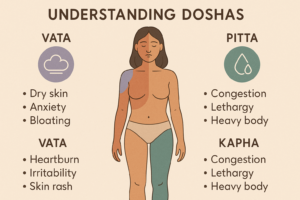
Look for reputable Panchakarma centers that offer:
- Certified BAMS Ayurvedic doctors
- Personalized, dosha-based treatment plans
- Authentic Ayurvedic herbs and oils
- Clean, quiet, and calming environments
Best Panchakarma centers in India:
- Varanasi
- Kerala
- Rishikesh
- Goa
Also available in top-rated U.S. Ayurvedic wellness clinics (California, Florida, Arizona)
Panchakarma vs Western Detox: What’s the Difference?
| Feature | Panchakarma | Western Detox |
| Focus | Mind, Body, Spirit | Mostly calorie or juice-based |
| Approach | Personalized, dosha-based | One-size-fits-all |
| Duration | 7–21 days | Usually 1–5 days |
| Support | Doctor-guided | Often DIY |
| Tools | Massage, oils, herbs, steam | Juices, pills, teas |
| Results | Holistic healing + detox | Short-term relief |
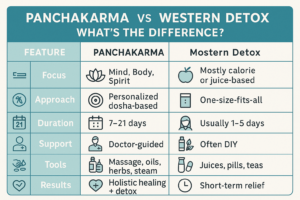
A Client Testimonial
“I tried Panchakarma for chronic fatigue and digestive issues. By Day 5, I felt lighter, not just in my body, but in my mind. It was more than a detox; it was a restart.” — Pankaj Singh Kushwaha, Varanasi (U.P.)
📥 Book Panchakarma Therapy Now
💆 Ready to start your detox journey?
👉 [Click Here to Book Your Panchakarma Session]
Final Thoughts: A Time-Tested Path to Total Wellness
Panchakarma is more than a detox — it’s a complete Ayurvedic cleansing and healing experience. It helps you reset not just your gut, but your mood, energy, and outlook on life.
✅ Backed by centuries of Ayurvedic wisdom
✅ Personalized to your body and needs
✅ Safe, natural, and profoundly effective
Start slow. Trust the process. Your body knows how to heal — it just needs the right tools.
FAQs About Panchakarma Therapy
Will I lose weight with Panchakarma?
Yes — many experience natural weight loss due to improved digestion and toxin removal.
Can I do Panchakarma at home?
Some mild steps (like ghee, steam) can be done at home, but full detox must be doctor-supervised.
Is it uncomfortable or painful?
Most steps are gentle. Some discomfort (headaches, fatigue) may occur — a sign of healing.
How often should I do it?
Traditionally, once or twice a year — often during seasonal transitions like spring and fall.
Helpful Resources & Further Reading
- National Ayurvedic Medical Association (NAMA)
- Effect of Panchakarma on Inflammation – PubMed
- Ayurveda and Panchakarma: The Science of Healing and Rejuvenation by Dr. Sunil Joshi
This article is medically reviewed by Dr. Komal Maurya, B.A.M.S, Certified Ayurvedic Doctor (Varanasi) with 8+ years of Panchakarma experience.
